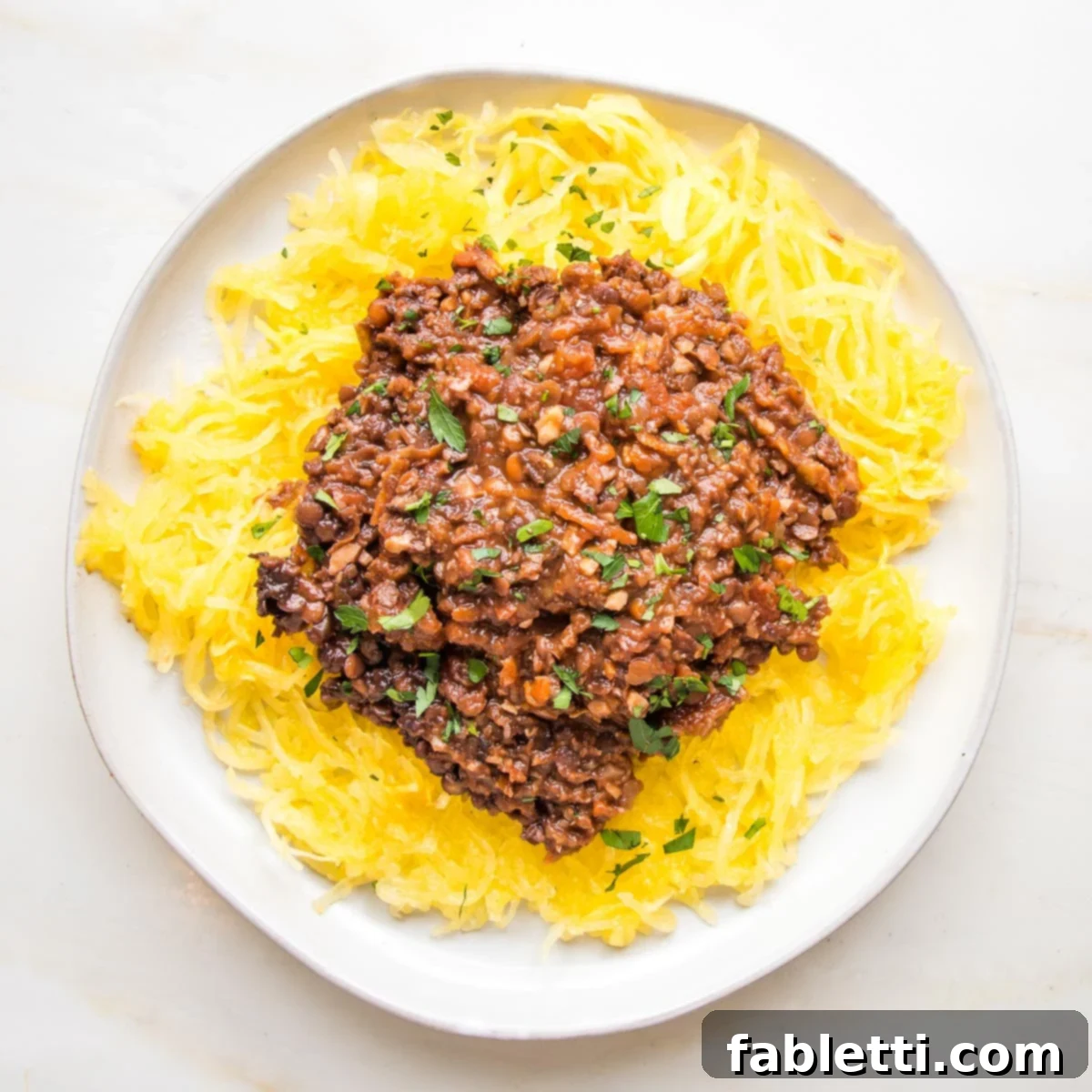The Ultimate Vegan Bolognese with Spaghetti Squash: A Hearty & Healthy Plant-Based Delight
Prepare to be amazed by this Vegan Bolognese Recipe – it’s so incredibly hearty and flavorful, even the most dedicated meat-eaters won’t miss a thing! Packed with robust, bold flavors and a rich umami depth from mushrooms and lentils, this isn’t just a plant-based bolognese; it’s a culinary experience you’ll find yourself craving time and again. We love to serve this wonderfully satisfying sauce atop perfectly cooked spaghetti squash for a dinner that’s both supremely nutritious and utterly delicious. It’s comfort food reinvented, providing all the warmth and satisfaction without any of the heaviness.
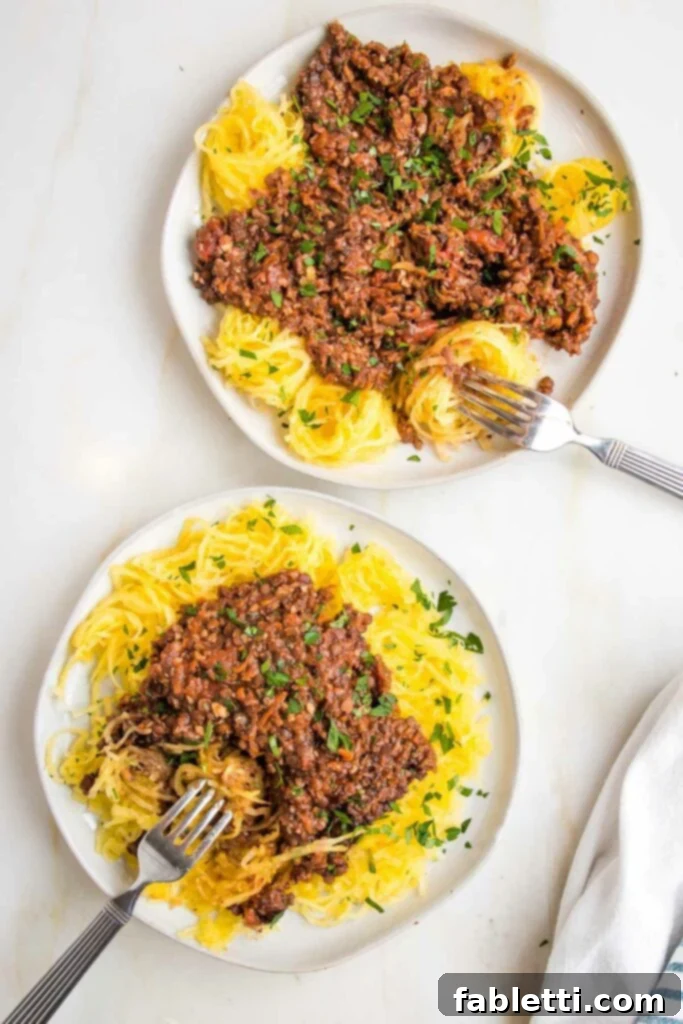
This comprehensive guide has been updated from its original posting on October 22, 2018, to provide enhanced details and clarity. This post may contain affiliate links, meaning that as an Amazon Associate, I earn from qualifying purchases at no additional cost to you. These links help support the creation of valuable content like this.
This easy vegetable bolognese, thoughtfully paired with spaghetti squash, offers a meal that is immensely satisfying, yet surprisingly light and healthy. Yes, you read that right – both attributes can coexist beautifully! This recipe embodies healthy comfort food at its absolute finest, delivering a nourishing dish that truly feels like a treat. It’s a brilliant way to enjoy a classic without the guilt, making it perfect for weeknight dinners or special occasions.
Our vegan bolognese sauce is a masterclass in layering flavors. It’s brimming with fresh, wholesome vegetables and expertly blended spices that create a vibrant, deeply flavored plant-based meal designed to delight everyone at your table. Whether you’re vegan, vegetarian, or simply looking to incorporate more plant-based meals into your diet, this rich and savory sauce will quickly become a household favorite. The spaghetti squash acts as a fantastic, low-carb and low-calorie base, ensuring this indulgent-tasting meal remains wonderfully balanced and keeps your nutritional goals in check.
Why You’ll Fall in Love with This Vegan Bolognese Recipe
This isn’t just another vegan recipe; it’s a culinary revelation that brings joy and satisfaction with every bite. Here’s why this spaghetti squash bolognese will become a cherished part of your recipe repertoire:
- Effortless Preparation with Wholesome Ingredients: You’ll find this recipe surprisingly easy to make, featuring ingredients that are readily available and familiar. There are no exotic items or complicated techniques, making it perfect for both novice and experienced cooks.
- Remarkably Nutrient-Dense: Experience a powerful nutritional punch for a modest calorie count. Every serving is packed with essential vitamins, minerals, and fiber, making it an ideal choice for anyone seeking wholesome, health-boosting meals that truly nourish the body.
- Rich, Full-Bodied Vegan Sauce: Our recipe captures the essence of a traditional Italian Bolognese, but with a completely plant-based twist. The depth of flavor and satisfying texture are so authentic, you’ll barely believe it’s vegan. It truly tastes like the classic dish you know and love, elevated with plant-based goodness.
- A Satisfying Plant-Based Dinner for Everyone: This hearty meal is guaranteed to please all palates, making it an excellent option for family dinners or entertaining guests with diverse dietary preferences. It’s a testament to how flavorful and fulfilling plant-based eating can be.
- Versatile Leftovers for Quick Meals: Don’t underestimate the power of a scoop of leftover vegan bolognese! It’s absolutely fabulous served cold or warm on top of a fresh, crisp salad, transforming simple greens into a gourmet delight. It’s a fantastic way to enjoy healthy, flavorful lunches throughout the week.
- The Ultimate Cold-Weather Comfort: When the temperatures drop, this warm and hearty dish is exactly what you need. Its rich flavors and satisfying texture provide comforting warmth, making it the perfect meal to cozy up with on chilly evenings.
- Light Yet Hugely Nutritious: While incredibly filling and robust in flavor, this dish remains remarkably light and nutrient-dense. It satisfies your deepest comfort food cravings without leaving you feeling weighed down, offering the best of both worlds.
- Guilt-Free Pasta Cravings: Say goodbye to highly processed, packaged pasta! By pairing our luscious vegan bolognese with nutrient-rich spaghetti squash, you can indulge your pasta cravings in a healthier, more wholesome way. It’s a smart and delicious swap that doesn’t compromise on taste or texture.
- Inclusive Dining (Vegan & Gluten-Free): This recipe is naturally vegan and gluten-free, making it accessible and enjoyable for nearly everyone. It’s designed to bring people together around a delicious meal, regardless of dietary restrictions.
Essential Ingredients and Clever Substitutions for Your Bolognese
Crafting the perfect vegan bolognese involves a thoughtful selection of ingredients, each contributing to its unique flavor and texture. Here’s a detailed look at what you’ll need, along with smart substitutions to cater to various preferences and pantry staples:
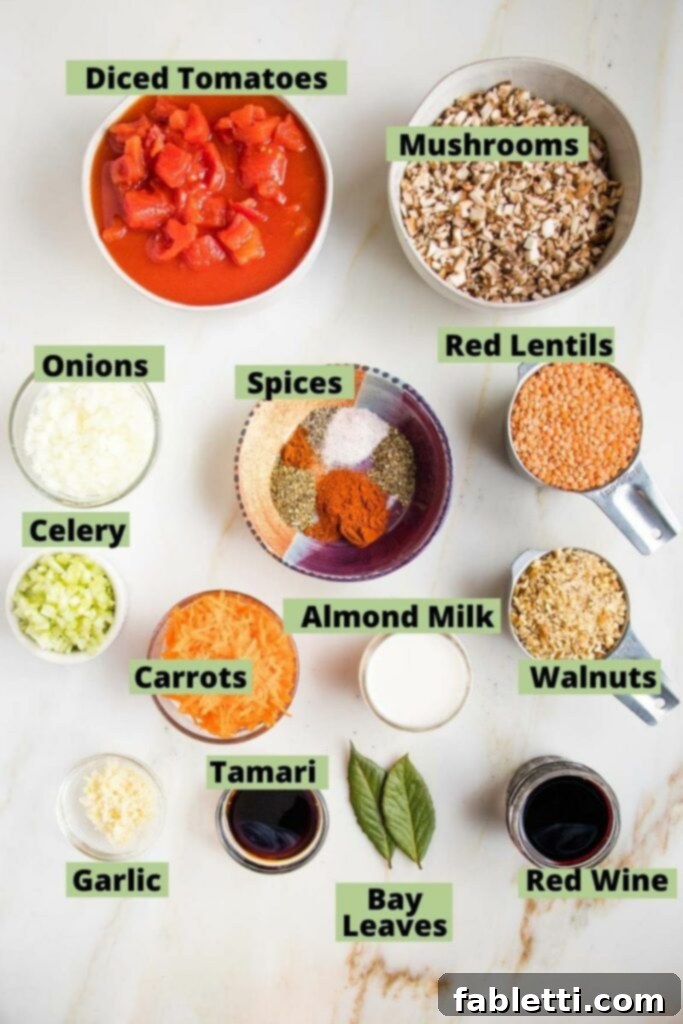
- Red Lentils: The Hearty Protein Base
These tiny powerhouses are not only an excellent source of plant-based protein and dietary fiber but also provide sustained energy and a remarkable sense of satiety. Their inclusion in this bolognese helps lower the risk of heart disease and, crucially, contributes a tender, crumbly texture that beautifully mimics traditional meat sauce. For substitutions, yellow split lentils work well; however, be mindful that black or brown lentils have a longer cooking time, require soaking, and won’t break down to the same consistency. - Mushrooms: Umami Powerhouses and Immunity Boosters
Beyond their incredible earthy flavor, mushrooms are nutritional champions. They are renowned for their immunity-boosting properties, their ability to help lower cholesterol, and their significant anti-inflammatory benefits. Rich in B and D vitamins, they also support brain health and possess notable cancer-fighting properties. In this recipe, mushrooms are the primary source of that coveted vegan umami. If you need to omit mushrooms, compensate by adding 1 tablespoon of miso paste for depth of flavor and an extra ¼ cup of finely chopped nuts for texture. - Walnuts: Omega-3 Rich & Gut-Friendly
Walnuts are a true superfood, providing a fantastic plant-based source of Omega-3 fatty acids, crucial for brain health and reducing inflammation. They are also rich in antioxidants and protein, promote a healthy gut microbiome, and can aid in weight management. For texture, finely chopped walnuts add a delightful bite reminiscent of ground meat. Feel free to substitute with any other finely chopped nut or seed, such as pecans, cashews, or sunflower seeds. - Tomatoes: Lycopene-Packed Flavor Foundation
Tomatoes form the vibrant, tangy base of any good bolognese. They are an excellent source of lycopene, a powerful antioxidant known for its role in lowering the risk of prostate cancer, heart disease, and macular degeneration. While diced tomatoes are ideal for texture, you can easily use crushed tomatoes or even a can of whole peeled tomatoes, which you can chop yourself for a rustic touch. - Onions, Carrots, Celery, Garlic: The Flavorful Mirepoix
This classic aromatic trio, known as mirepoix (along with garlic), forms the foundational layer of flavor for our bolognese. These humble vegetables are flavor builders that also contribute a wealth of low-calorie, plant-based nutrients. The shredded carrots, in particular, add a subtle sweetness and a pleasant, tender texture that blends seamlessly into the sauce. - Spices: Aromatic Essentials
Our spice blend draws from Italian traditions, featuring aromatic basil and oregano, which provide classic herbaceous notes. Paprika is added to infuse a bold, warm flavor and a beautiful reddish hue, creating a complex and inviting aroma that fills your kitchen. - Red Wine: Deepening the Flavor Profile
Traditional bolognese recipes often call for red wine, and for good reason: it’s a brilliant way to build profound flavor without relying on excessive salt or fat. As the alcohol evaporates during cooking, it leaves behind a concentrated balance of sweet and savory notes that truly elevates the sauce. If you prefer to avoid alcohol, a fantastic substitute is tomato juice, enhanced with a teaspoon of vegan Worcestershire sauce for that extra layer of savory depth. - Tamari: Gluten-Free Savory Enhancer
I opt for low-sodium, gluten-free tamari, which imparts a wonderful savory depth and umami without adding unnecessary sodium. It’s an excellent way to boost the overall flavor profile. Good substitutes include coconut aminos for a soy-free option, or 1 tablespoon of light miso paste mixed with 1 tablespoon of water, which will also provide a rich umami note. - Almond Milk: Creamy Richness
Any unsweetened plant-based milk would work beautifully in this recipe to add a touch of creamy richness and help bind the sauce. Homemade almond milk is surprisingly easy to make and, when available, offers a fresh, clean flavor. Oat milk or soy milk are also excellent choices for a similar effect.
Discover the Versatility of Spaghetti Squash
Spaghetti squash is a true marvel of the plant world, offering a delightful and nutritious alternative to traditional pasta. Its unique texture and mild flavor make it an ideal canvas for rich sauces like our Vegan Bolognese. Here’s why this winter squash deserves a permanent spot in your healthy eating rotation:

- A Nutrient-Dense Pasta Alternative: Far more than just a carb-saver, spaghetti squash is a fantastic nutritional choice. It’s significantly lower in carbohydrates and calories compared to traditional pasta, while providing a good dose of essential nutrients like Vitamin C, beta-carotene, and dietary fiber. It’s the perfect foundation for a health-conscious meal.
- Achieve Perfect Pasta-Like Strands: The secret to getting those long, tender strands that truly resemble spaghetti lies in the preparation method. We’ll guide you through specific directions below to ensure your spaghetti squash comes out perfectly “stringy” and al dente, ready to absorb every drop of our delicious bolognese.
- Inedible Skin, Delicious Flesh: It’s important to remember that the skin of spaghetti squash is not edible. However, the delicate, tender flesh inside is where all the magic happens. Once cooked, it effortlessly separates into those beloved spaghetti-like strands.
- Neutral, Buttery Flavor Profile: One of the greatest attributes of this versatile winter squash is its naturally neutral, mild, and subtly buttery flavor. This characteristic makes it exceptionally adaptable, as it readily takes on the vibrant flavors of whatever sauce you choose to pair with it. In this case, it allows our rich vegan bolognese to truly shine, without overpowering its complex notes.
Mastering Perfect Spaghetti Squash Strands
Achieving those long, tender, pasta-like strands from your spaghetti squash is simpler than you might think, and it largely depends on how you initially cut and prepare it. The first crucial step is to prep the squash in a way that allows some of its natural moisture to release, ensuring you end up with firm, distinct noodles rather than a watery, mushy texture. Follow these steps for flawless results:
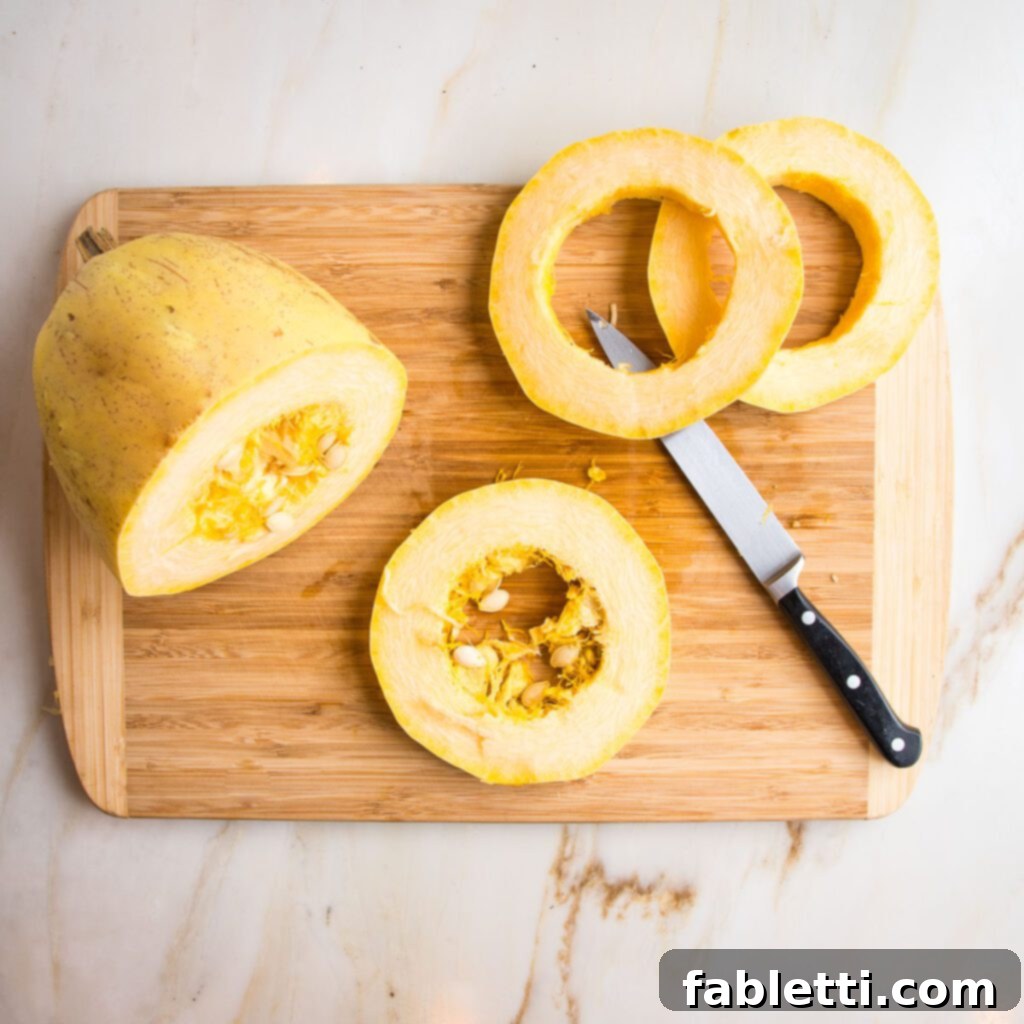
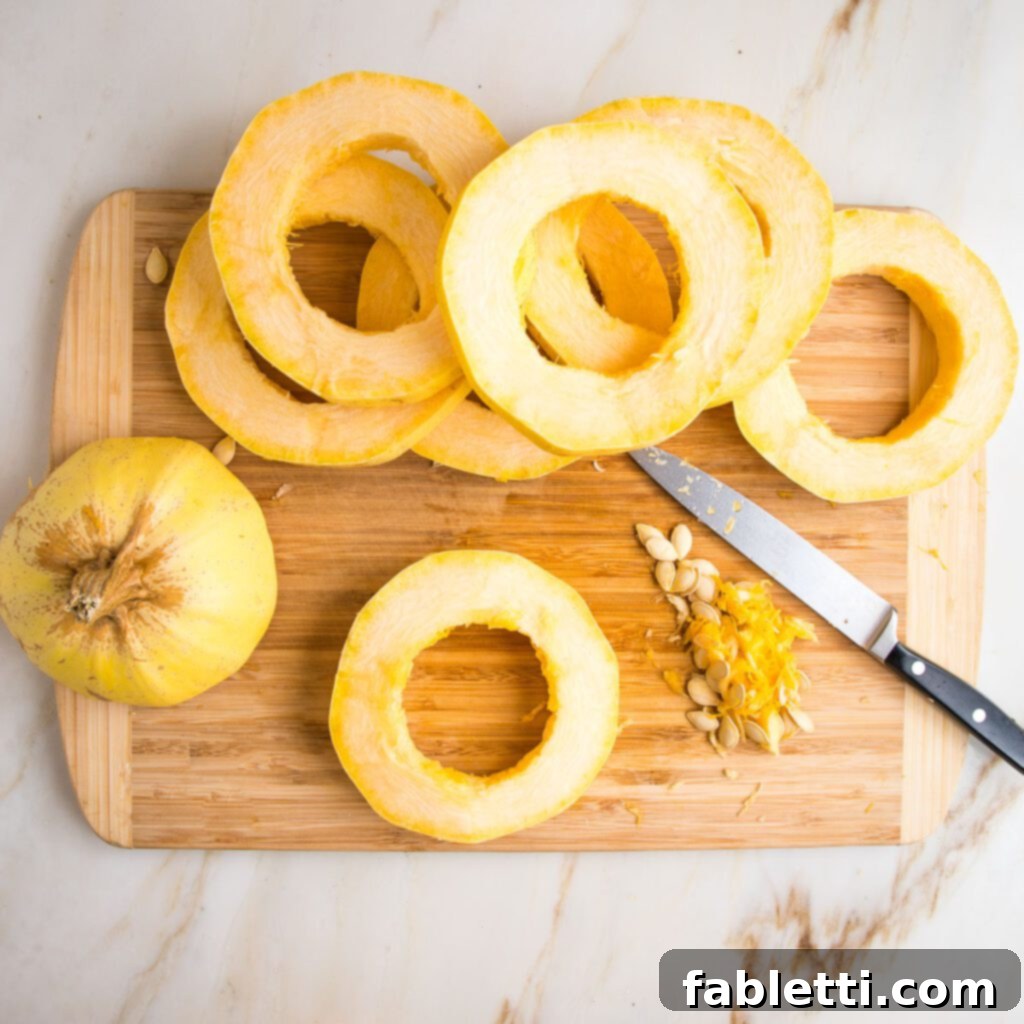
Begin by using a very sharp knife to carefully cut the spaghetti squash into 1 to 2-inch horizontal rings. This is a critical technique: cutting horizontally, rather than the more common vertical cut, is what allows you to achieve those wonderfully long, tender, and al dente noodle-like strands, similar to angel hair pasta. A 5-inch utility knife or a sturdy paring knife can make this task considerably easier and safer. Once you have your rings, use your knife or a spoon to carefully scoop out the stringy, seedy center, leaving you with perfect donut-shaped rings of squash flesh.
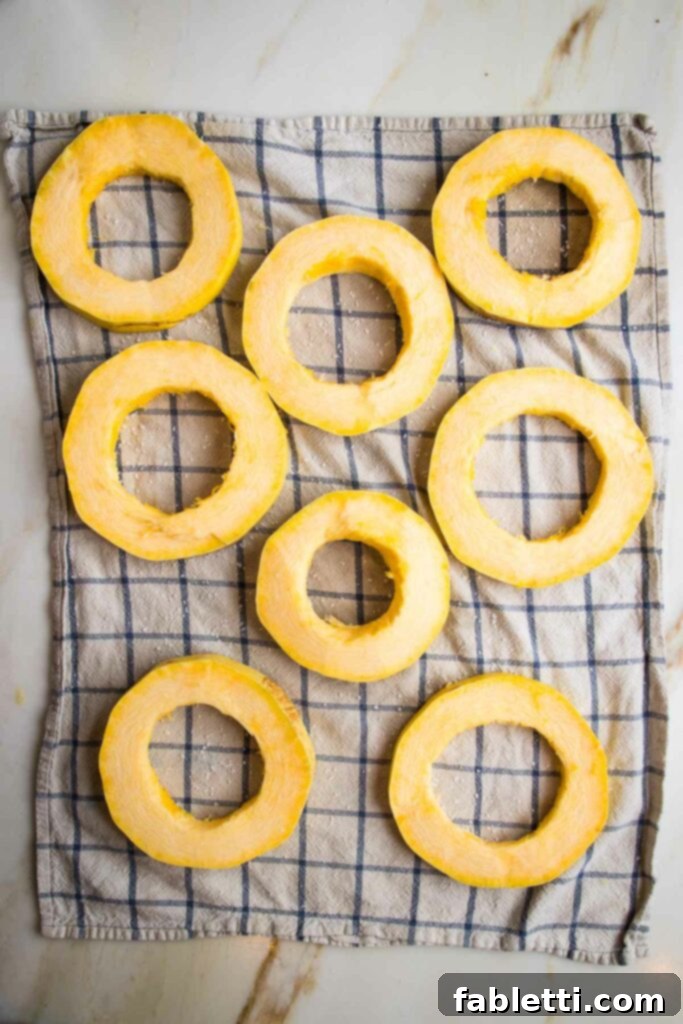
Next, lay your spaghetti squash rings out in a single layer on a clean kitchen towel. Generously sprinkle them with kosher salt. This simple but effective step is vital for drawing out excess moisture from the squash, which prevents it from becoming soggy during roasting and helps achieve that desirable al dente texture. Allow these salted rings to sit for approximately 15-20 minutes. After this “sweating” period, use a paper towel to gently brush off any accumulated salt and water before you proceed with roasting. This ensures your squash strands will be firm and perfectly separated.
While your spaghetti squash rings are releasing their moisture, this is the perfect time to begin preparing your vegan bolognese sauce. The active cooking process for the bolognese moves quite quickly, so it’s essential to have all your ingredients prepped and ready to go before you even turn on the stove. This is known as “mise en place” and it makes cooking a breeze. Start by gathering all your vegetables: finely dice the onion, shred the carrot (using a box grater for efficiency), cut the celery into small, uniform dice, and mince the garlic. For extra ease, a microplane grater can be used to zest the garlic for a more intense flavor. Ensure your mushrooms are diced into small pieces, and likewise, finely chop the walnuts. A spice grinder can make quick work of chopping the walnuts evenly.
Once your ingredients are prepped, the bolognese will come together seamlessly. You’re now ready to build those incredible layers of flavor!
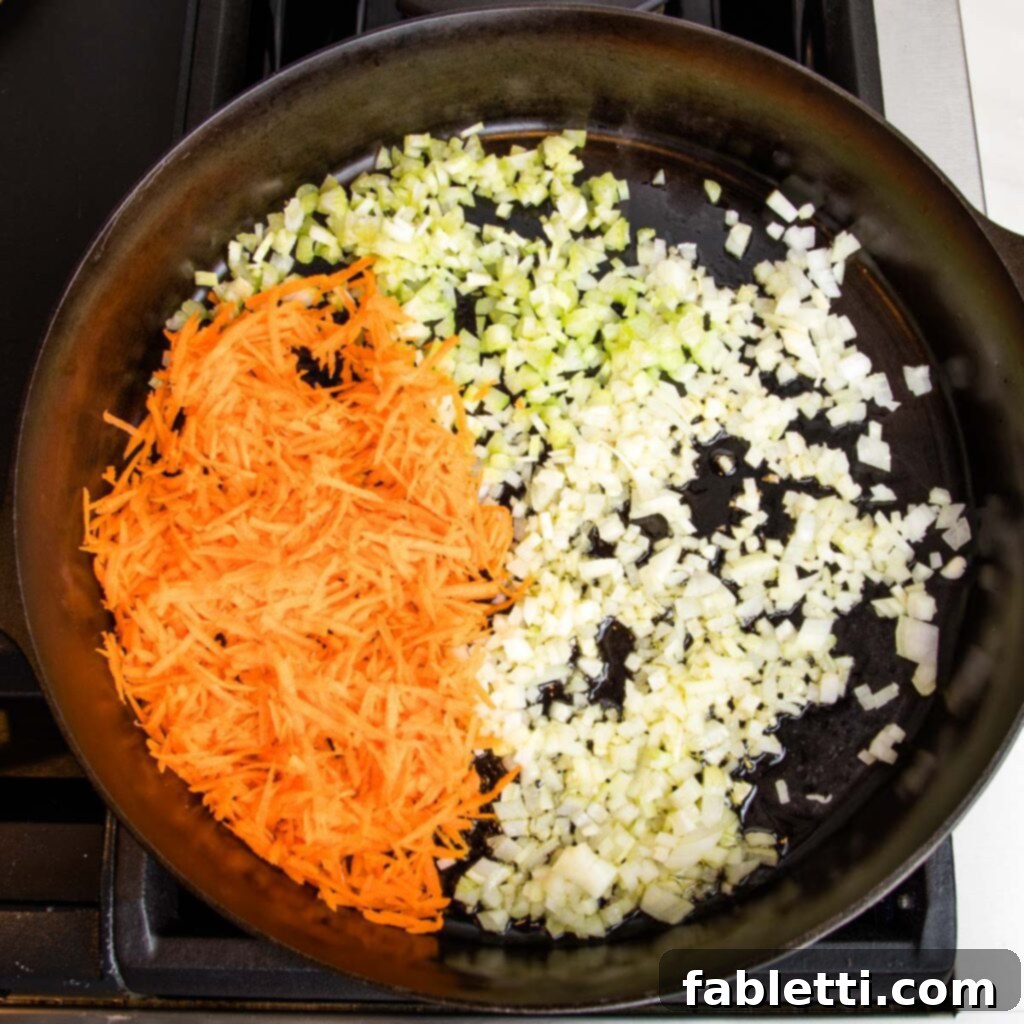
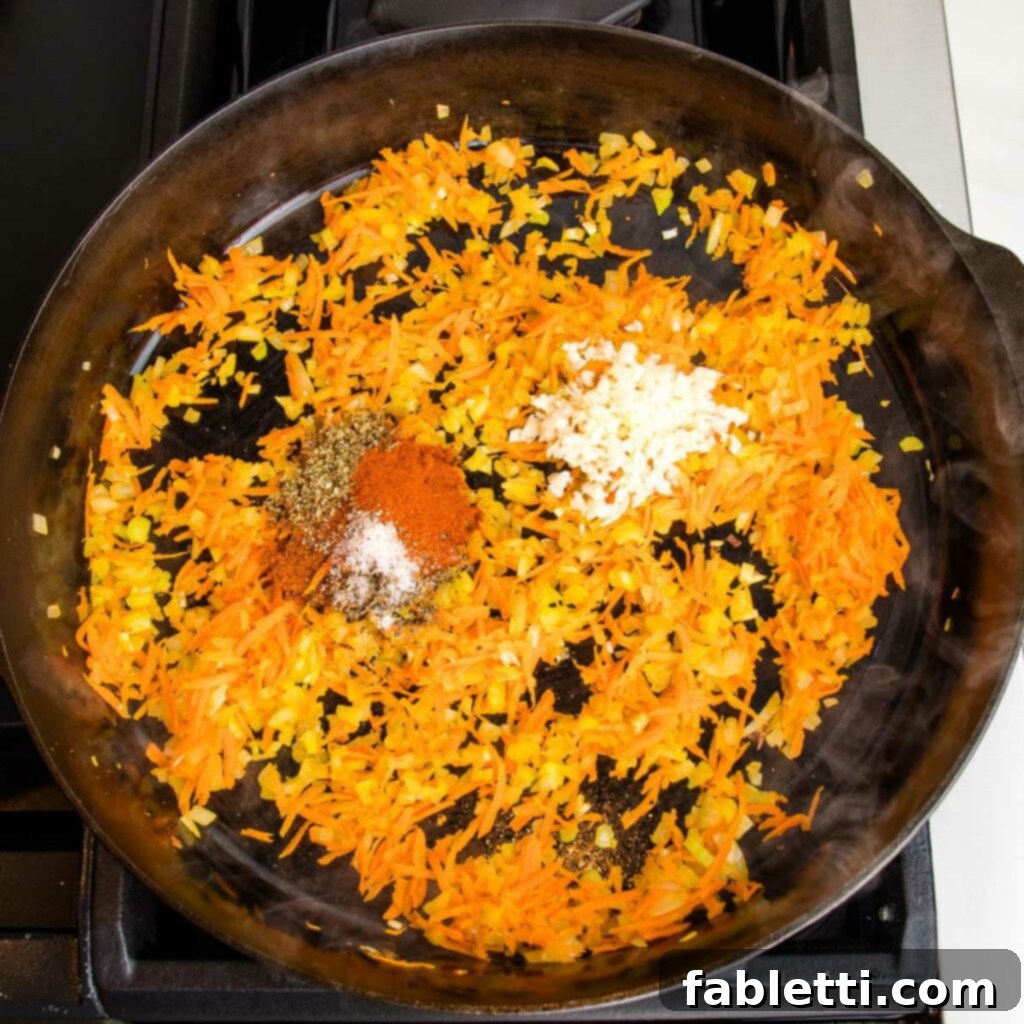
In a large, heavy-bottomed skillet (a cast iron skillet works wonderfully for even heat distribution), begin by sautéing your diced onions, celery, and shredded carrots over medium heat. Cook them gently, stirring occasionally, until the onions become translucent and the vegetables start to soften, which usually takes about 5 to 7 minutes. This step is crucial for developing the foundational sweetness and savory base of your bolognese. Once softened, add in the minced garlic and your chosen blend of dried spices. Stir constantly for about 1 minute, being careful not to let the garlic burn, as burnt garlic can impart a bitter flavor to the sauce.


Next, stir in your small diced mushrooms. Continue to cook, stirring regularly, until the mushrooms soften considerably and release their natural juices. This process usually takes another 5 to 7 minutes and is essential for building their umami flavor. Once the mushrooms are tender, add the well-rinsed red lentils and the finely chopped walnuts to the skillet. Mix all the ingredients thoroughly, ensuring the lentils and walnuts are evenly distributed and coated with the aromatic vegetable mixture.
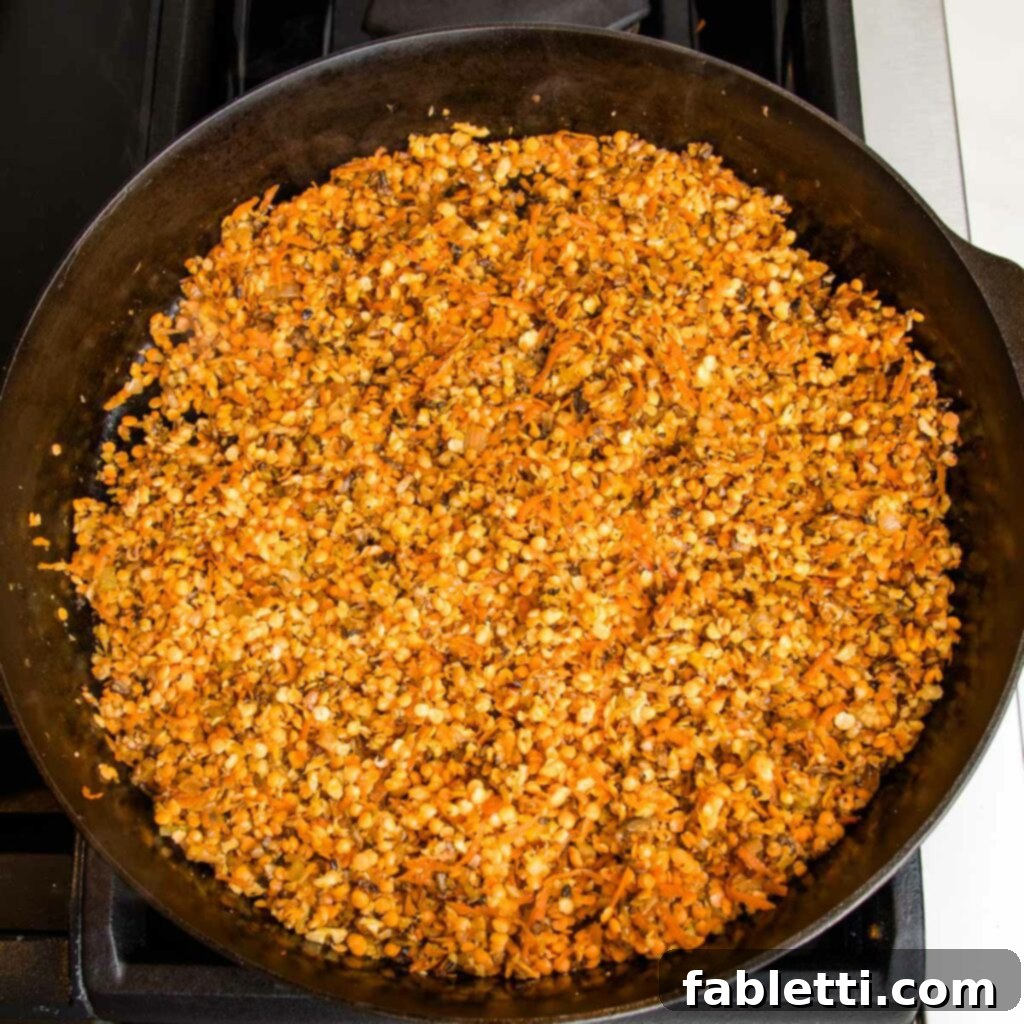

It’s time to deglaze the pan. Pour in the red wine, and with a wooden spoon or spatula, scrape up any flavorful browned bits that have stuck to the bottom of the skillet. These “fond” pieces are packed with concentrated flavor and will significantly deepen the taste of your bolognese. After deglazing, stir in the diced tomatoes, almond milk, and tamari, mixing all the components well until everything is thoroughly combined and the sauce starts to take on its characteristic rich color.
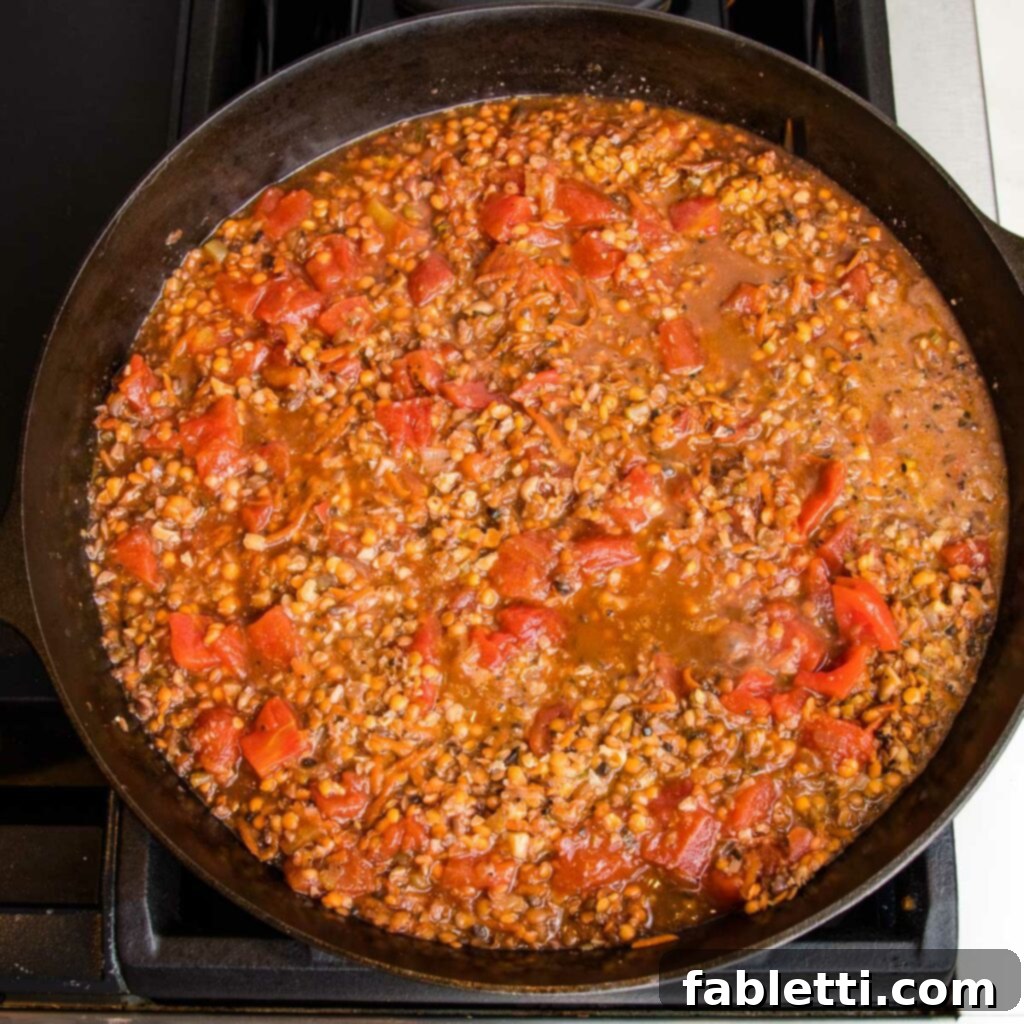

Stir the sauce thoroughly and bring it to a gentle boil. Once boiling, reduce the heat to a low simmer, add the bay leaves, and let the bolognese cook for 30 minutes. Stir occasionally to prevent sticking and ensure even cooking. After the first 15 minutes of simmering, add ½ cup of water to the sauce, stir well, and continue cooking at a low simmer. This replenishes moisture and allows the flavors to meld beautifully, creating a rich, complex sauce.


Now, shift your attention back to the spaghetti squash. Using a clean paper towel, carefully wipe off any residual salt and the moisture that has accumulated on the rings. This step is crucial for achieving firm, non-soggy strands. Arrange the cleaned squash rings in a single layer on a parchment-lined baking sheet. If necessary, use two trays to avoid overcrowding, which can lead to steaming rather than roasting. Drizzle the squash with a touch of olive oil and season generously with salt and pepper. Roast in a preheated 425°F (220°C) oven for approximately 25 minutes, or until the squash is tender but still retains a slight firmness – you want it cooked through, not mushy.
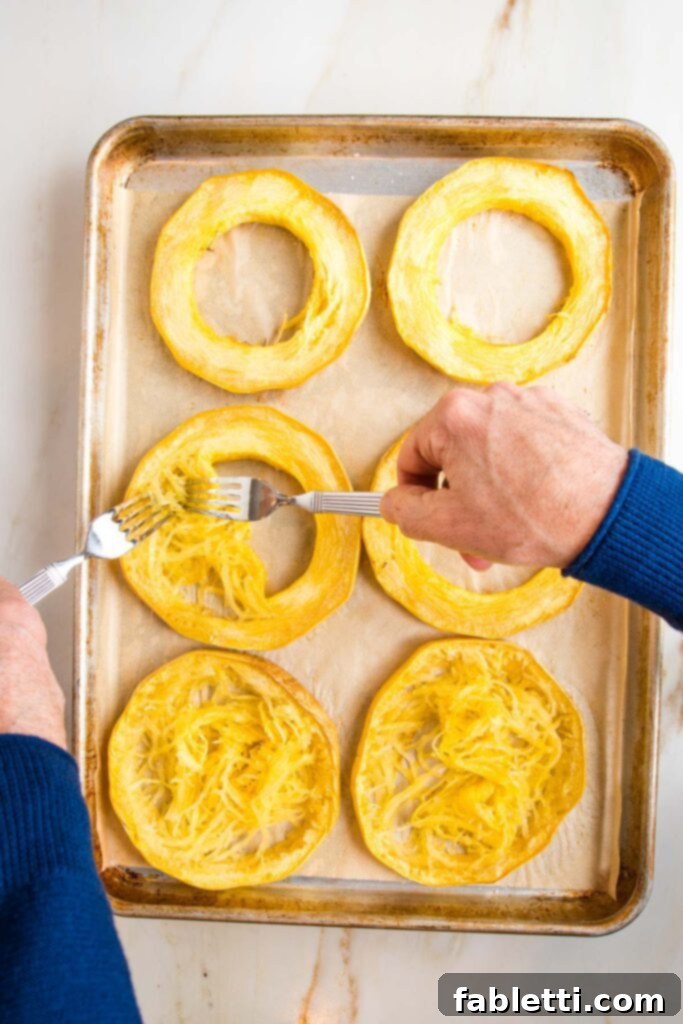
Once the spaghetti squash is perfectly roasted and cool enough to handle, use two forks to gently pull the delicate spaghetti strands away from the squash skin. You’ll find that the flesh easily separates and remains beautifully intact, resembling long, tender angel hair pasta. Continue this process until all the squash rings have yielded their wonderful strands. Transfer the cooked spaghetti squash onto a large serving platter or individual plates, creating a perfect bed ready for your luscious vegan bolognese sauce.
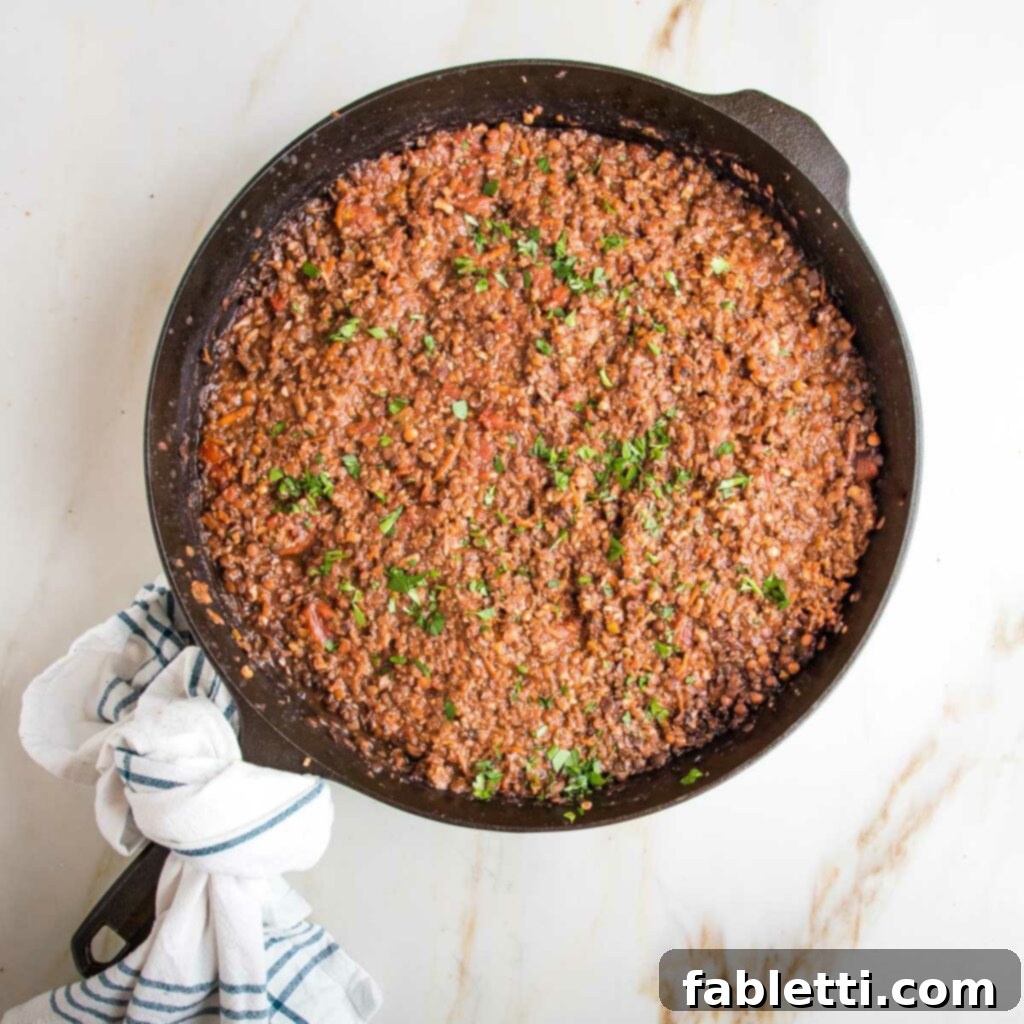
Finally, remove the bay leaves from your red lentil bolognese. You can serve the sauce as is, showcasing its delightful chunky texture with all the visible vegetables and lentils. Alternatively, for a smoother, more refined sauce that resembles a traditional ragu, you can use an immersion blender to partially purée a portion of the sauce directly in the pot. This optional step allows you to customize the texture to your preference, creating a luxurious and slightly creamy consistency while still retaining some delightful chunks. Whichever texture you choose, your vegan bolognese is now ready to be generously spooned over the spaghetti squash and savored.
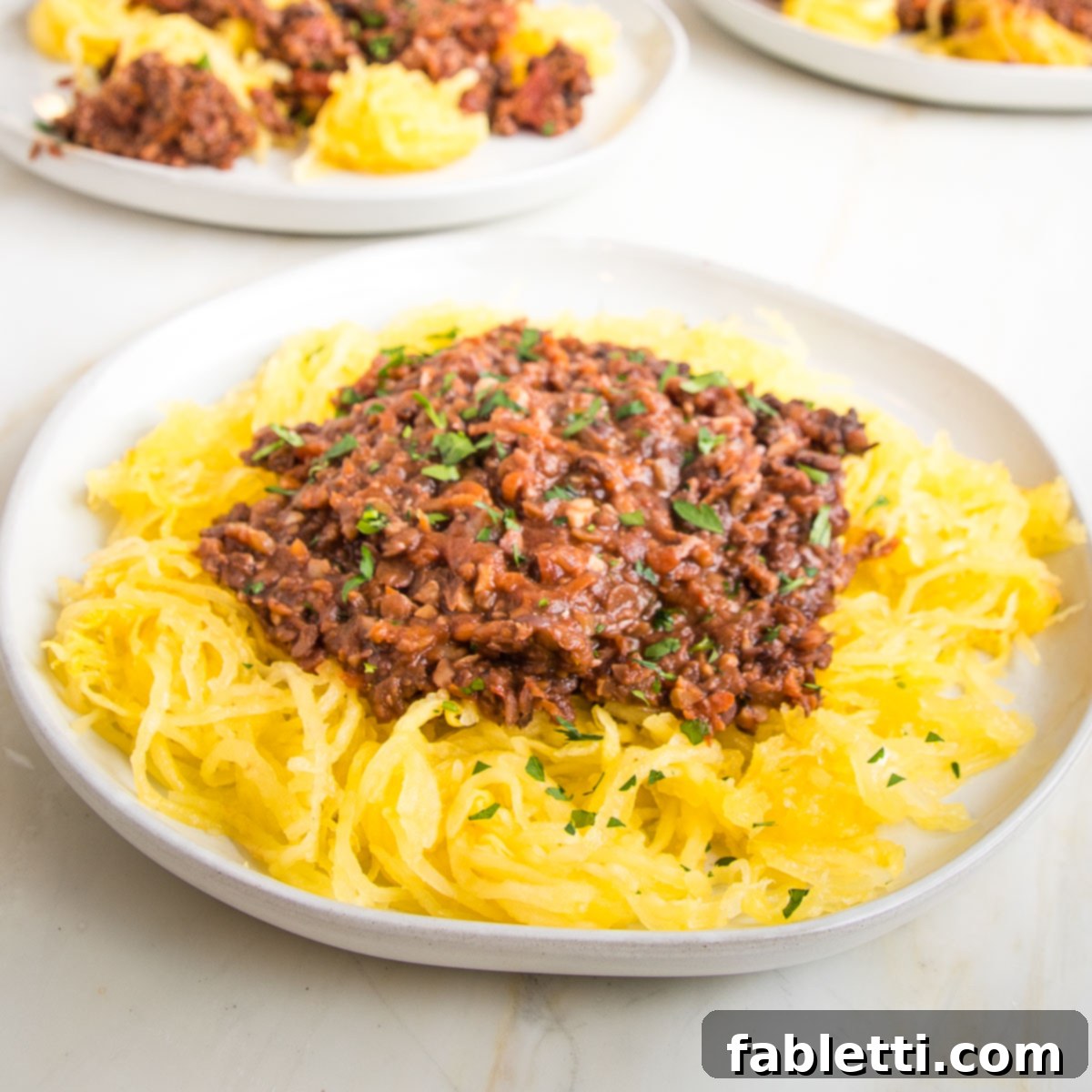
Debra’s Pro Tips for the Best Vegan Bolognese
Unlock the full potential of this incredible dish with these expert tips, designed to elevate your cooking and ensure a perfect outcome every time:

- Don’t Skip the Squash Salting Step: It truly is worth the extra minute to sprinkle your spaghetti squash rings with salt before roasting. This crucial step effectively draws out excess moisture, which is the secret to ensuring your “pasta” strands are perfectly al dente and not soggy. It makes all the difference in achieving that ideal texture.
- Customize Your Bolognese Texture: Feel free to experiment with the texture of your bolognese to match your preference. I personally enjoy a varied texture, so I use an immersion blender to partially purée a portion of it. This creates a delightful blend that is both creamy and still satisfyingly chunky, resembling a rich ragu. If your pan doesn’t have high sides, be aware that blending directly in the pot can cause splattering. For a cleaner process, you might consider transferring a portion of the sauce to a standard blender, puréeing it, and then mixing it back into the pot.
- Smart Storage for Leftovers: To maintain optimal freshness and texture, always store leftover spaghetti squash separately from the vegan bolognese sauce. The squash tends to become softer and more watery when mixed with sauce for extended periods. When you’re ready to reheat and enjoy your meal, simply combine the two, and they’ll taste just as delicious as when freshly made.
What to Serve With Roasted Spaghetti Squash
The beauty of spaghetti squash lies in its mild, slightly buttery flavor, which makes it incredibly versatile. I often enjoy it simply seasoned with a sprinkle of salt and crushed red pepper. However, its neutral taste also means it acts as a perfect canvas, readily absorbing the flavors of any sauce you pair it with, allowing the sauce to truly shine. While our insanely delicious vegetable ragu is a top contender, if you’re looking for other inspired sauce ideas to complement your roasted spaghetti squash, here are some of my absolute favorite choices:
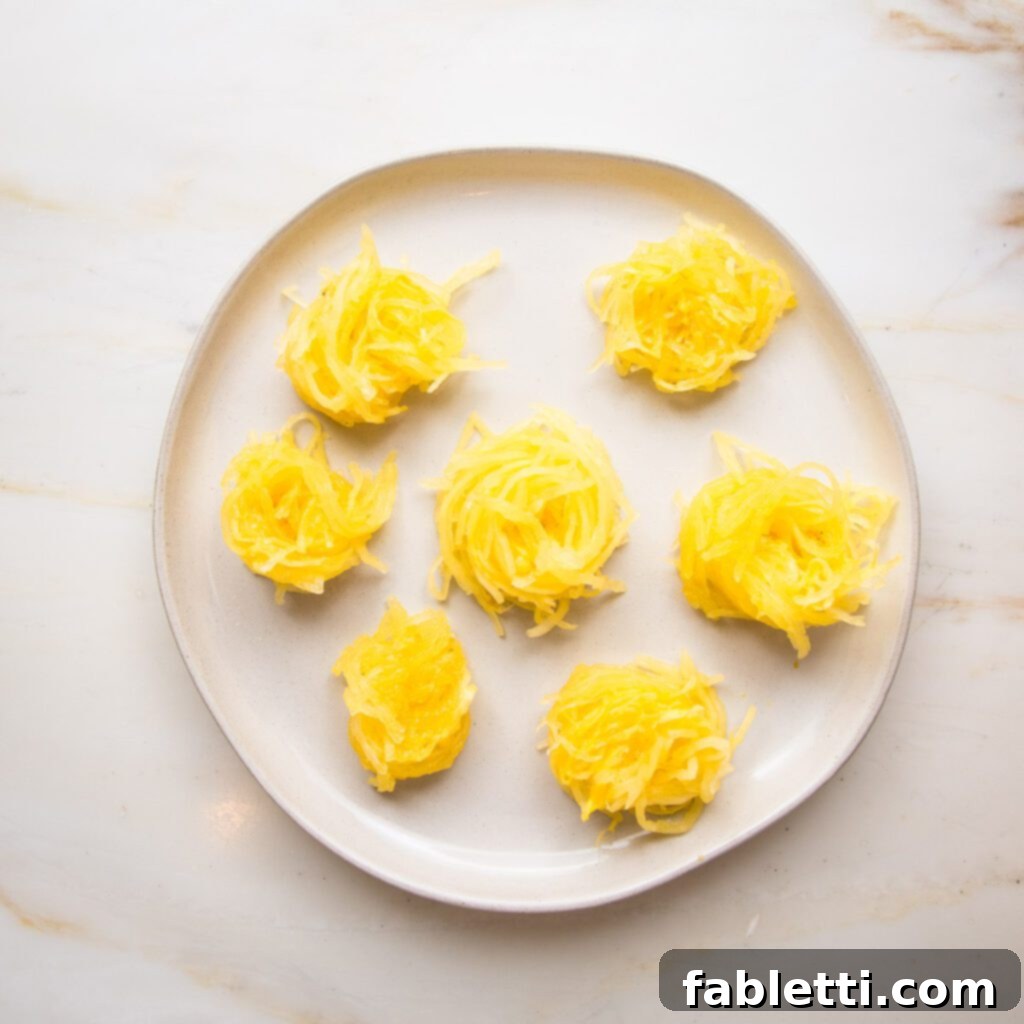
- Vegan Mushroom Stroganoff Recipe: This pairing is an absolute dream! The rich, creamy, and decadent flavors of the mushroom stroganoff perfectly complement the lightness of the spaghetti squash, creating a harmonious and incredibly tasty meal that feels indulgent yet remains healthy.
- Vegan Basil Pesto: If you’re a fan of delicate angel hair pasta tossed with vibrant pesto, you will absolutely adore this match. The fresh, aromatic basil pesto clings beautifully to the spaghetti squash strands, creating a light, herbaceous, and utterly refreshing dish.
- Easy Vegan Gravy: I know, I know… it might sound a bit unconventional, but trust me on this one! My husband swears by this combination, and once you try it, you might too. The savory, comforting gravy adds a surprising and delicious depth to the mild squash.
- Oil-Free Romesco: To transform this vibrant dip into a creamy, dreamy, and decadent sauce, simply add ½ cup of almond milk. This luscious sauce can be whipped up in just 5 minutes using simple pantry ingredients, offering a quick and flavorful topping for your squash.
- Carrot Top Pesto: Explore another exciting way to enjoy pesto! This creative recipe proves there’s more than one path to deliciousness, especially when fresh basil isn’t always readily available. It’s an inventive and flavorful alternative that minimizes food waste.
- Green Tahini Sauce: This versatile sauce is simply divine and tastes good on practically everything! Its creamy, zesty, and herbaceous notes complement the spaghetti squash beautifully, and best of all, it takes just 5 minutes to prepare.
Perfect Pairings for Red Lentil Bolognese
Honestly, this red lentil bolognese is so rich in flavor and satisfying in texture that I sometimes find myself eating it straight from the pot with a spoon! Its remarkable depth of flavor and hearty composition make it a wonderfully fulfilling dish all on its own. However, if you’re seeking other creative ways to serve this delicious vegan lentil bolognese—whether for a fresh meal or to repurpose any leftovers—here are my top recommendations for truly complementary pairings:
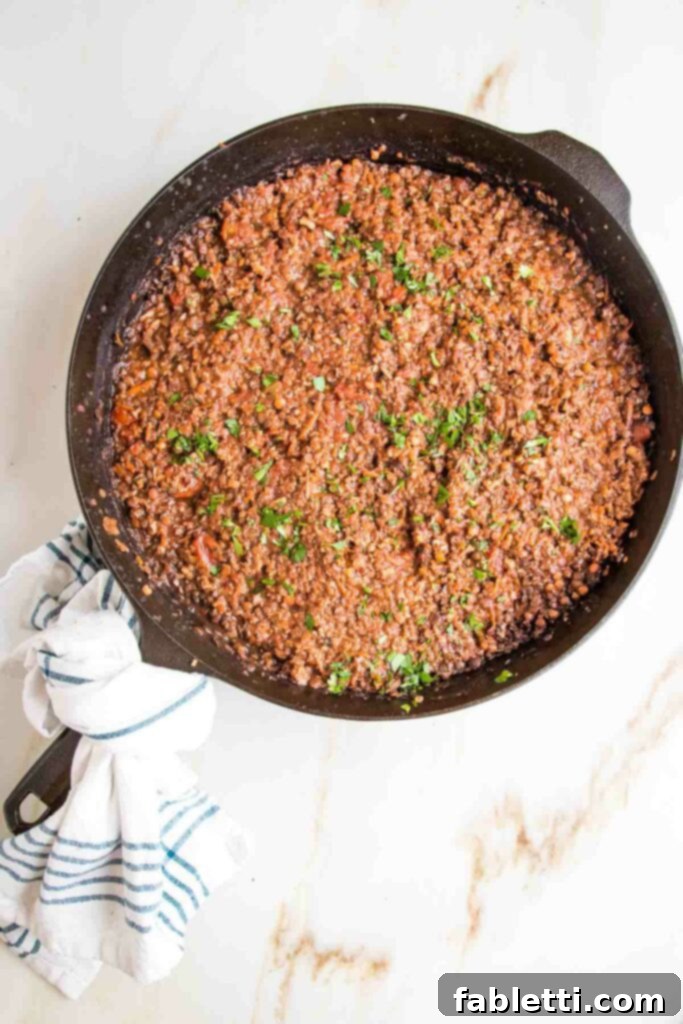
- Basic Cauliflower Rice: For a truly low-carb and nutrient-packed meal, a bed of simple cauliflower rice is an excellent choice. This quick recipe takes just 5 minutes to prepare – which is precisely why I always keep riced cauliflower in my freezer! Its mild flavor provides the perfect accompaniment to the robust vegetable bolognese.
- Whole Roasted Cauliflower: Elevate your dining experience with a spectacularly decadent whole roasted cauliflower, generously smothered with this flavorful vegan ragu. It’s one of our favorite special occasion vegan meals, offering an impressive presentation and an explosion of taste.
- Roasted Veggies Medley: Gather whatever fresh vegetables you have on hand – broccoli florets, bell peppers, zucchini, or green beans work beautifully. Chop them into bite-sized pieces, drizzle with a little olive oil, season with salt and pepper, and roast at 425°F (220°C) for 15-20 minutes until tender-crisp. Then, simply mix them directly into the bolognese sauce for an even more vibrant and nutrient-rich vegetable bolognese.
- Mashed Potatoes and Root Vegetables: This pairing is an absolute no-brainer and delivers incredible comfort. Imagine creamy, healthy vegan mashed potatoes (perhaps with parsnips or sweet potatoes) generously smothered in this protein-rich, super-satisfying sauce. Sign me up for this delightful combination!
- Vegan Dinner Rolls: Use these amazing and easy-to-make rolls to create an unforgettable “sloppy joe” experience. Simply split a roll and scoop in a generous portion of this chunky vegan ragu for a hearty, handheld meal that’s bursting with flavor.
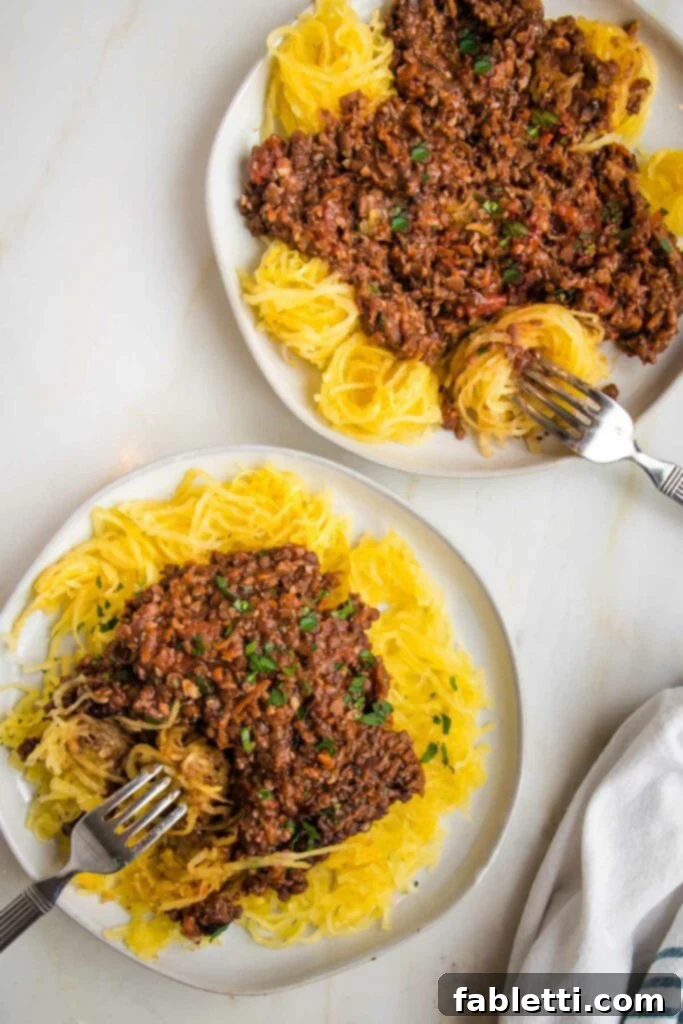
Meal Prep and Storage Tips
Planning ahead makes healthy eating easier and more enjoyable. Here’s how to effectively meal prep and store your vegan bolognese and spaghetti squash:
- SERVE: When ready to enjoy, plate your spaghetti squash and generously ladle on the warm bolognese sauce. For an extra touch of freshness and flavor, sprinkle with chopped fresh parsley, a pinch of crushed red pepper for a subtle kick, and a dusting of nutritional yeast for a cheesy, umami finish.
- PREP AHEAD: The vegan bolognese sauce is an excellent candidate for advance preparation. It can be made entirely ahead of time and stored in the refrigerator, allowing its flavors to deepen and meld even further. For the best texture, the spaghetti squash is ideally prepared just before serving.
- STORE: Leftover spaghetti squash, when stored separately in an airtight container in the refrigerator, will remain fresh for up to 3 days. The bolognese sauce, also stored in an airtight container, will keep beautifully in the fridge for up to 5 days, making it perfect for weekday lunches and dinners.
- FREEZE: For longer storage, ensure your bolognese sauce is completely cool before transferring it to freezer-safe containers. It will maintain its quality in the freezer for up to 3 months. Unfortunately, spaghetti squash does not freeze well; its texture tends to become mushy and watery upon thawing.
- REHEAT: To reheat the bolognese sauce, gently warm it on the stovetop over medium-low heat, stirring occasionally, until heated through. For spaghetti squash, preheat your oven to 350°F (175°C) and reheat for about 15 minutes, or until it’s warm and tender. Combining the reheated squash and sauce just before serving ensures optimal texture and temperature.
📖 Recipe
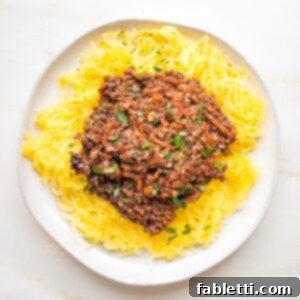
Vegan Bolognese over Spaghetti Squash
Rate this Recipe
Pin Recipe
Equipment
- Hand blender
- Wooden Spoon Set
- Half Sheet Baking Pans
- Cast iron skillet
- Box Grater
Ingredients
Spaghetti Squash
- 1 medium Spaghetti Squash
- Drizzle of Olive Oil*
- Salt + Pepper
Vegan Bolognese Sauce
- 1 large onion diced
- 4 cloves garlic minced
- 1 medium carrot shredded
- 1 stalk celery small dice
- 1 teaspoon paprika
- ½ teaspoon dried basil
- ½ teaspoon dried oregano
- ½ teaspoon coarse sea salt
- ¼ teaspoon ground black pepper
- ⅛ teaspoon cayenne pepper
- 2 cups assorted mushrooms * diced
- 1 cup red lentils rinsed well and picked over
- ¾ cup finely chopped walnuts*
- ½ cup red wine*
- 1 28-oz can diced tomatoes
- ½ cup almond milk*
- 2 Tablespoons Tamari
- 2 Bay Leaves
Instructions
- Carefully slice your spaghetti squash horizontally into 1 to 2-inch thick rings. After scooping out the seeds and stringy bits, these rings will resemble donuts. A medium-sized sharp knife or even a paring knife will work well, provided it’s sharp to ensure ease and safety. Arrange the squash rings in a single layer on a clean kitchen towel and sprinkle generously with coarse salt. Allow them to “sweat” for about 15-20 minutes to draw out excess moisture, which is key for a non-soggy, pasta-like texture.
- While the squash is resting, begin your bolognese. In a large skillet, warm a drizzle of oil over medium heat. Add the diced onion and sauté for 5 minutes until it becomes translucent and slightly softened. Then, stir in the minced garlic, shredded carrots, small-diced celery, and all your dried spices. Cook for another 3 minutes, stirring constantly to prevent the garlic from burning. Next, add the diced mushrooms. Continue to stir and cook for about 5 minutes until the mushrooms have softened and released their natural juices, intensifying their umami flavor.
- Preheat your oven to 425°F (220°C). Line a large baking tray with unbleached parchment paper. You may need two trays if your squash is large, as a single layer is important for proper roasting.
- Back to the bolognese: Stir in the rinsed lentils and finely chopped walnuts, mixing them well with the sautéed vegetables. Pour in the red wine to deglaze the skillet, scraping up any delicious browned bits from the bottom of the pan to infuse more flavor into the sauce. Then, add the diced tomatoes, almond milk, and tamari, mixing thoroughly. Finally, add the bay leaves, bring the sauce to a boil, then reduce the heat to a low simmer and cook for 15 minutes.
- Now, prepare your squash for roasting. Using a paper towel, gently brush off all the coarse salt and any liquid that has accumulated on the squash rings. Arrange them in a single layer on your prepared baking pan. Drizzle them with a little olive oil and sprinkle with fresh salt and pepper. (See the “Notes” section below if you prefer to cook without oil). Roast the squash in your preheated 425°F (220°C) oven for 25 minutes, until it’s tender but still firm to the bite – you want it cooked through, not mushy.
- While the spaghetti squash rings are roasting, check on your bolognese sauce. Stir it well. After the initial 15 minutes of simmering, add ½ cup of water, stir again, and continue cooking over low heat for another 15 minutes. Stir occasionally to ensure nothing sticks to the bottom of the pot and that the flavors continue to meld beautifully.
- Once both the squash and bolognese are tender and cooked to perfection, remove the bay leaves from the sauce. At this point, you can assess its chunkiness. I personally like to use an immersion blender to partially blitz a portion of the sauce. This creates a thicker, slightly less chunky consistency that more closely resembles a traditional ragu, while still retaining some textural interest. This step is entirely optional and subjective; the sauce will be equally delicious whether you purée it or keep it chunky.
- When the roasted squash rings are tender, use two forks to gently pull the spaghetti-like strands away from the edges and the skin. Gather these beautiful strands onto a serving platter or individual plates, creating a perfect bed for your rich sauce.
- Generously ladle the warm vegan bolognese sauce onto the prepared spaghetti squash. For an added burst of flavor and visual appeal, sprinkle with fresh herbs (such as parsley or basil), a pinch of crushed red pepper for a little heat, and some nutritional yeast, if desired, for a cheesy, savory finish. Serve immediately and enjoy!
Notes
MUSHROOMS: I used a delightful combination of shiitake and baby bella mushrooms for this recipe, which adds complexity and depth. However, any fresh mushroom variety will work wonderfully. If you need to omit mushrooms, add 1 tablespoon of light miso paste to the sauce for an umami boost and an additional ¼ cup of finely chopped walnuts for more textural interest.
LENTILS: Red lentils are ideal for this bolognese as they cook quickly and break down beautifully, contributing to the sauce’s tender texture. If you must substitute, the only other lentil I would recommend for this recipe is split yellow lentils. Other varieties, like brown or black lentils, would require pre-soaking and a significantly longer cooking time to achieve a similar consistency.
WALNUTS: To cut down on your prep time, consider using a spice grinder for finely chopping the walnuts. You can also substitute walnuts with other nuts, such as pecans or cashews, or even seeds like pumpkin or sunflower seeds. Just ensure they are very finely chopped to integrate well into the sauce’s texture.
RED WINE: If you need an alcohol-free substitute for the red wine, tomato juice or even V8 juice work perfectly to add a similar depth of flavor and acidity to the bolognese.
TO STORE: The bolognese sauce will remain fresh and delicious in an airtight container in the refrigerator for up to 5 days, or it can be frozen for up to 3 months. Always store leftover spaghetti squash separately to maintain its best texture. To reheat, warm the sauce on the stovetop and the squash in a 350°F (175°C) oven for about 20 minutes, or until thoroughly heated.
Nutrition
Note
The nutrition calculations provided were estimated using online tools. To obtain the most accurate representation of the nutritional information for any given recipe, you should calculate the nutritional values with the actual ingredients you used. You are ultimately responsible for ensuring that any nutritional information is accurate, complete, and useful for your specific dietary needs.
